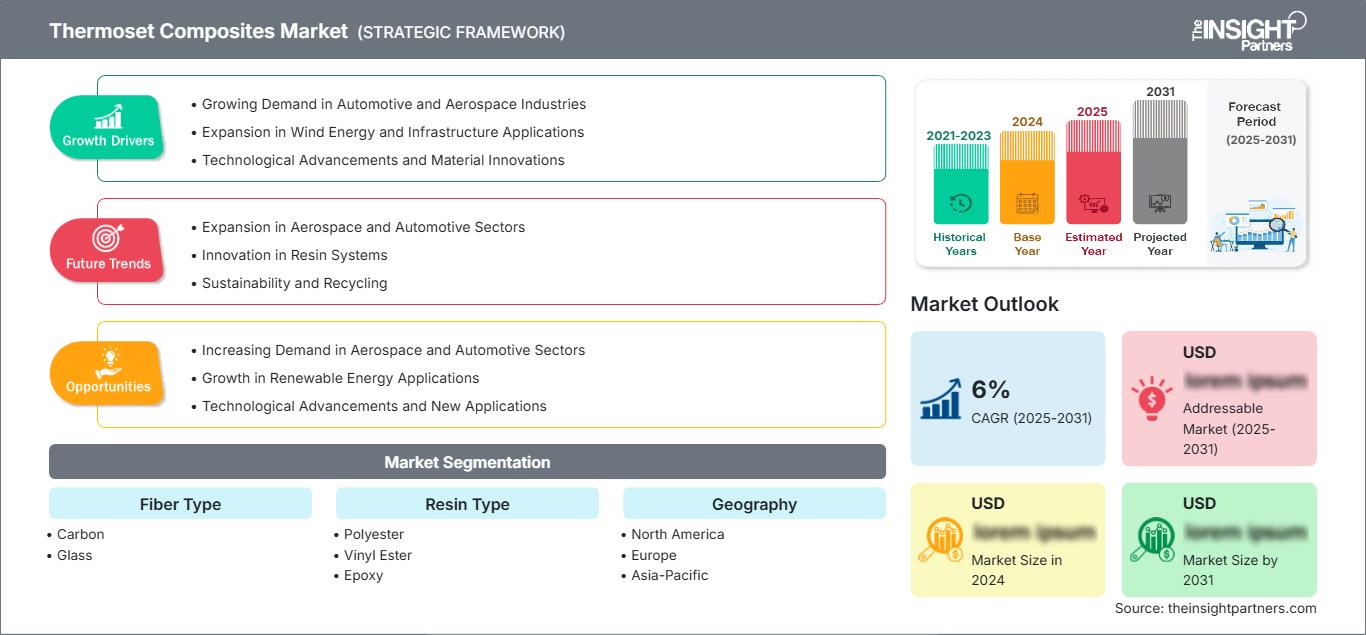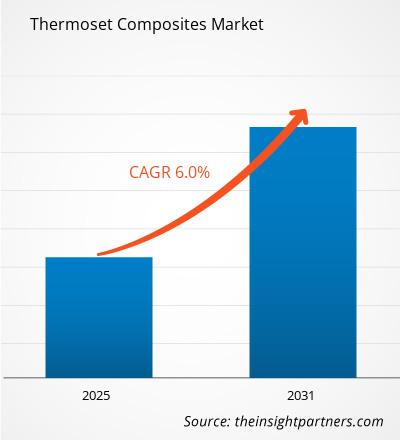Der Markt für duroplastische Verbundwerkstoffe wird voraussichtlich zwischen 2025 und 2031 eine durchschnittliche jährliche Wachstumsrate (CAGR) von 6 % verzeichnen, wobei sich das Marktvolumen von XX Millionen US-Dollar im Jahr 2024 auf XX Millionen US-Dollar im Jahr 2031 ausweitet.
Der Bericht zum Markt für duroplastische Verbundwerkstoffe ist nach Fasertyp (Kohlenstoff, Glas und andere) segmentiert. Der Markt ist nach Harztyp (Polyester, Vinylester, Epoxid, Polyurethan und andere) segmentiert. Der Markt ist nach Herstellungsverfahren (Lay-up-Verfahren, Filamentwickelverfahren, Spritzgussverfahren, Pultrusionsverfahren, Harzinfusion und andere) segmentiert. Der Markt ist nach Endverbrauchsbranchen (Luft- und Raumfahrt und Verteidigung, Automobil, Schifffahrt, Bauwesen, Windenergie, Sportartikel und andere) segmentiert. Der Umfang umfasst die Marktgröße und -prognose auf globaler, regionaler und Länderebene für alle wichtigen Marktsegmente. Der Bericht bietet den Wert in USD für die oben genannte Analyse, Segmente, Regionen und Länder. Der Bericht behandelt Markttrends sowie Marktdynamiken wie Treiber, Einschränkungen und wichtige Chancen. Der Bericht enthält außerdem eine Branchen- und Wettbewerbsanalyse, die Marktkonzentration, Heatmap-Analysen, wichtige Akteure und aktuelle Entwicklungen auf dem Markt umfasst.
Zweck des Berichts
Der Bericht „Markt für thermosetische Verbundwerkstoffe“ von The Insight Partners beschreibt die aktuelle Marktsituation und das zukünftige Wachstum sowie die wichtigsten treibenden Faktoren, Herausforderungen und Chancen. Dies bietet verschiedenen Geschäftspartnern Einblicke, wie z. B.:
- Technologieanbieter/-hersteller: Um die sich entwickelnde Marktdynamik zu verstehen und die potenziellen Wachstumschancen zu erkennen, damit sie fundierte strategische Entscheidungen treffen können.
- Investoren: Um eine umfassende Trendanalyse hinsichtlich der Marktwachstumsrate, der finanziellen Marktprognosen und der Chancen entlang der Wertschöpfungskette durchzuführen.
- Regulierungsbehörden: Um Richtlinien und Überwachungsaktivitäten auf dem Markt zu regulieren, mit dem Ziel, Missbrauch zu minimieren, das Vertrauen der Investoren zu wahren und die Integrität und Stabilität des Marktes aufrechtzuerhalten.
Marktsegmentierung für Duroplast-Verbundwerkstoffe: Fasertyp
- Kohlenstoff
- Glas
Harztyp
- Polyester
- Vinylester
- Epoxid
- Polyurethan
Sie erhalten kostenlos Anpassungen an jedem Bericht, einschließlich Teilen dieses Berichts oder einer Analyse auf Länderebene, eines Excel-Datenpakets sowie tolle Angebote und Rabatte für Start-ups und Universitäten.
Markt für duroplastische Verbundwerkstoffe: Strategische Einblicke

- Holen Sie sich die wichtigsten Markttrends aus diesem Bericht.Dieses KOSTENLOSE Beispiel umfasst Datenanalysen, die von Markttrends bis hin zu Schätzungen und Prognosen reichen.
Wachstumstreiber für Duroplast-Verbundwerkstoffe
- Steigende Nachfrage in der Automobil- und Luftfahrtindustrie: Duroplast-Verbundwerkstoffe werden in der Automobil- und Luftfahrtindustrie aufgrund ihres hohen Festigkeits-Gewichts-Verhältnisses, ihrer Langlebigkeit und ihrer Fähigkeit, extremen Temperaturen und rauen Bedingungen standzuhalten, häufig eingesetzt. Im Automobilbereich tragen sie dazu bei, das Fahrzeuggewicht zu reduzieren, die Kraftstoffeffizienz zu verbessern und die Sicherheit zu erhöhen. Auch in der Luft- und Raumfahrt sind diese Verbundwerkstoffe von entscheidender Bedeutung für die Herstellung leichter und leistungsstarker Komponenten wie Tragflächen, Rümpfe und Innenraumteile. Die steigende Nachfrage nach kraftstoffsparenden und leistungsstarken Fahrzeugen und Flugzeugen treibt den Markt für Duroplast-Verbundwerkstoffe an.
- Expansion in der Windenergie- und Infrastrukturanwendung: Duroplast-Verbundwerkstoffe, insbesondere solche mit Kohlenstoff- und Glasfasern, werden in der Windenergiebranche aufgrund ihrer überlegenen mechanischen Eigenschaften und ihrer Fähigkeit, den Umweltbedingungen im Freien standzuhalten, häufig für Turbinenblätter verwendet. Mit dem Wachstum der Branche der erneuerbaren Energien, insbesondere der Windkraft, steigt die Nachfrage nach Duroplast-Verbundwerkstoffen. Darüber hinaus werden diese Materialien im Bauwesen und in der Infrastruktur zur Betonverstärkung und zur Herstellung robuster, leichter Komponenten eingesetzt, was ihre Verbreitung in diesen Sektoren fördert.
- Technologische Fortschritte und Materialinnovationen: Fortschritte in der Technologie für duroplastische Verbundwerkstoffe, wie z. B. verbesserte Harzformulierungen und die Entwicklung effizienterer Herstellungsverfahren (z. B. automatisierte Faserplatzierung und Harztransferpressen), erweitern ihre Anwendungsmöglichkeiten. Diese Innovationen ermöglichen die Herstellung kostengünstigerer, leistungsfähigerer und leichterer duroplastischer Verbundwerkstoffe, was ihre Verbreitung in Branchen wie der Automobil-, Luft- und Raumfahrt- und erneuerbaren Energien-Industrie vorantreibt.
Markttrends für duroplastische Verbundwerkstoffe
- Expansion in der Luft- und Raumfahrt- sowie Automobilindustrie: Duroplastische Verbundwerkstoffe werden in der Luft- und Raumfahrt- sowie Automobilindustrie zunehmend für leichte und dennoch langlebige Komponenten wie Flugzeugteile, Karosserieteile und Strukturelemente eingesetzt. Diese Verbundwerkstoffe bieten hohe Leistung in anspruchsvollen Umgebungen, tragen zur Gewichtsreduzierung und Verbesserung der Kraftstoffeffizienz bei. Mit der steigenden Nachfrage nach Elektrofahrzeugen (EVs) und modernen Flugzeugen wächst der Markt für duroplastische Verbundwerkstoffe in diesen Sektoren.
- Innovation bei Harzsystemen: Die Entwicklung fortschrittlicher duroplastischer Harzsysteme wie Epoxid-, Polyester- und Vinylesterharze treibt das Marktwachstum voran. Diese Innovationen verbessern die Eigenschaften von duroplastischen Verbundwerkstoffen wie thermische Stabilität, mechanische Festigkeit und Korrosionsbeständigkeit. Daher werden duroplastische Verbundwerkstoffe zunehmend in Branchen wie der Windenergie, der Schifffahrt und dem Bauwesen eingesetzt, in denen Haltbarkeit und Leistung entscheidend sind.
- Nachhaltigkeit und Recycling: Angesichts wachsender Umweltbedenken gibt es einen Trend zu nachhaltigen duroplastischen Verbundwerkstoffen, die leichter recycelt oder wiederverwendet werden können. Obwohl duroplastische Verbundwerkstoffe traditionell schwer zu recyceln sind, machen Fortschritte in der Harztechnologie und bei Recyclingprozessen diese Materialien umweltfreundlicher. Dieser Trend gewinnt an Bedeutung, insbesondere in Branchen wie der Automobil- und Baubranche, in denen Unternehmen Wert auf Abfallreduzierung und Minimierung der Umweltauswirkungen ihrer Produkte legen.
Marktchancen für Duroplaste
- Steigende Nachfrage in der Luft- und Raumfahrt sowie im Automobilsektor: Duroplaste werden aufgrund ihrer Festigkeit, Haltbarkeit und Hitze- und Korrosionsbeständigkeit sehr geschätzt. Diese Eigenschaften machen sie ideal für Anwendungen in der Luft- und Raumfahrt sowie im Automobilsektor, wo leichte, leistungsstarke Materialien entscheidend sind. Mit der wachsenden Nachfrage nach kraftstoffsparenden Fahrzeugen und der Expansion der Luft- und Raumfahrtindustrie wird die Verwendung von Duroplasten voraussichtlich deutlich zunehmen, insbesondere bei Strukturkomponenten, Motorteilen und Innenraumelementen.
- Wachstum bei Anwendungen für erneuerbare Energien: Duroplaste werden zunehmend im Bereich der erneuerbaren Energien eingesetzt, insbesondere bei der Herstellung von Windturbinenblättern. Der Bedarf an leichten, starken und langlebigen Materialien, die rauen Umweltbedingungen standhalten, treibt die Nachfrage nach Duroplasten in der Windenergie. Da der weltweite Vorstoß in Richtung sauberer Energie anhält, wird die Nachfrage nach diesen Materialien im Bereich erneuerbarer Energien voraussichtlich steigen.
- Technologische Fortschritte und neue Anwendungen: Fortschritte bei duroplastischen Verbundwerkstoffen, wie die Entwicklung leistungsstarker, kostengünstiger Harze und verbesserter Herstellungsverfahren wie Resin Transfer Molding (RTM), erweitern die potenziellen Anwendungsmöglichkeiten dieser Verbundwerkstoffe. Branchen wie das Baugewerbe, die Schifffahrt und die Sportartikelindustrie setzen zunehmend auf duroplastische Verbundwerkstoffe aufgrund ihrer verbesserten Leistung, Designflexibilität und Fähigkeit, strenge gesetzliche Anforderungen zu erfüllen.
Regionale Einblicke in den Markt für duroplastische Verbundwerkstoffe
Die Analysten von The Insight Partners haben die regionalen Trends und Faktoren, die den Markt für duroplastische Verbundwerkstoffe im Prognosezeitraum beeinflussen, ausführlich erläutert. In diesem Abschnitt werden auch die Marktsegmente und die geografische Lage für duroplastische Verbundwerkstoffe in Nordamerika, Europa, im asiatisch-pazifischen Raum, im Nahen Osten und Afrika sowie in Süd- und Mittelamerika erörtert.
Umfang des Marktberichts zu duroplastischen Verbundwerkstoffen
| Berichtsattribut | Einzelheiten |
|---|---|
| Marktgröße in 2024 | US$ XX million |
| Marktgröße nach 2031 | US$ XX Million |
| Globale CAGR (2025 - 2031) | 6% |
| Historische Daten | 2021-2023 |
| Prognosezeitraum | 2025-2031 |
| Abgedeckte Segmente |
By Fasertyp
|
| Abgedeckte Regionen und Länder | Nordamerika
|
| Marktführer und wichtige Unternehmensprofile |
|
Marktdichte der Akteure im Bereich Duroplast-Verbundwerkstoffe: Auswirkungen auf die Geschäftsdynamik verstehen
Der Markt für duroplastische Verbundwerkstoffe wächst rasant. Die steigende Nachfrage der Endverbraucher ist auf Faktoren wie veränderte Verbraucherpräferenzen, technologische Fortschritte und ein stärkeres Bewusstsein für die Produktvorteile zurückzuführen. Mit der steigenden Nachfrage erweitern Unternehmen ihr Angebot, entwickeln Innovationen, um den Bedürfnissen der Verbraucher gerecht zu werden, und nutzen neue Trends, was das Marktwachstum weiter ankurbelt.

- Holen Sie sich die Markt für duroplastische Verbundwerkstoffe Übersicht der wichtigsten Akteure
Wichtige Verkaufsargumente
- Umfassende Abdeckung: Der Bericht analysiert umfassend Produkte, Dienstleistungen, Typen und Endnutzer des Marktes für duroplastische Verbundwerkstoffe und bietet einen ganzheitlichen Überblick.
- Expertenanalyse: Der Bericht basiert auf dem umfassenden Verständnis von Branchenexperten und Analysten.
- Aktuelle Informationen: Der Bericht gewährleistet Geschäftsrelevanz durch die Berichterstattung über aktuelle Informationen und Datentrends.
- Anpassungsoptionen: Dieser Bericht kann an spezifische Kundenanforderungen angepasst werden und passt sich optimal an die Geschäftsstrategien an.
Der Forschungsbericht zum Markt für duroplastische Verbundwerkstoffe kann daher dazu beitragen, die Branchensituation und die Wachstumsaussichten zu entschlüsseln und zu verstehen. Obwohl es einige berechtigte Bedenken geben kann, überwiegen die Vorteile dieses Berichts tendenziell die Nachteile.
- Historische Analyse (2 Jahre), Basisjahr, Prognose (7 Jahre) mit CAGR
- PEST- und SWOT-Analyse
- Marktgröße Wert/Volumen – Global, Regional, Land
- Branchen- und Wettbewerbslandschaft
- Excel-Datensatz
Aktuelle Berichte
Erfahrungsberichte
Grund zum Kauf
- Fundierte Entscheidungsfindung
- Marktdynamik verstehen
- Wettbewerbsanalyse
- Kundeneinblicke
- Marktprognosen
- Risikominimierung
- Strategische Planung
- Investitionsbegründung
- Identifizierung neuer Märkte
- Verbesserung von Marketingstrategien
- Steigerung der Betriebseffizienz
- Anpassung an regulatorische Trends






















 Kostenlose Probe anfordern für - Markt für duroplastische Verbundwerkstoffe
Kostenlose Probe anfordern für - Markt für duroplastische Verbundwerkstoffe